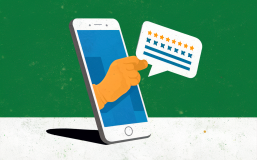Revenue growth is priority #1 for most businesses today. So, good salespeople are in demand, and management wants to give them the best possible tools to make them productive. Selling is a numbers game. As long as you do reasonably sensible things, the time invested tends to corelate to revenue earned. Therefore, productivity really does matter. This is not an area to skimp on. If you can make somebody who brings in $1 million in revenue 10% more productive, that would mean an additional $100,000. So, what is happening in the market with tools for those who hustle on the front lines of business, the people who sell the products and services, who get capital for your business and sell it when the time comes, who hire the people who can grow your business? What will they be using in future?

The Post-CRM Opportunity
Back in pre-historic days (before email) the big productivity boost came from digitizing paper rolodexes into contact management systems like Act! and Goldmine. This is still the baseline, and these vendors have updated their products well. Salespeople who became accustomed to these simple tools tended to object when somebody told them to switch.
Which is what happened when CRM came along. These individual contact management tools were not considered enterprise-quality. But from the individual sales guy’s point of view, CRM was all too often something imposed on them by management, with two objectives:
- To generate reports automatically. The biggest chore for managers is reporting. The good ones want to spend their time coaching, motivating, and recruiting, not reporting. So, individual salespeople did benefit indirectly, but it was not often perceived that way. In too many cases, CRM was seen as a burden put on the front-line revenue generators to make their managers’ lives easier.
- To get all salespeople’s contacts into one system. Salespeople hoard good contacts. They are their primary asset. Salespeople are only as good as their last quarter and get fired easily if they don’t perform, so it is natural for them to hoard their most productive asset.
It’s All Email
CRM was invented before email became the dominant form of communication. But by the time CRM grew up, it was all email all the time. CRM does a good job of tracking contacts across email, phone, fax, mail, and, if you configure it correctly, carrier pigeon and telepathy. This is great, but we still spend 90% of our time, when not face to face or on the phone, on email. CRM, then, starts to look like a distraction from email. So, we integrated CRM with email. But the reality is, we still spend most of our computer time on email.
This “email first, plus all the other bits” (calendar, tasks, contacts) mentality is why Outlook remains so incredibly entrenched, despite its basic flawed architecture (being PC-centric, not web-centric). Gmail, with Google’s laudable loose coupling, is not as well integrated as Outlook.
Hit The Road Jack and Get Some Face-to-Face Time
A wise sales manager tracks the F2F time of her or his salespeople. Anything other than selling F2F is just preparation or follow-up. Sales is a contact sport, always has been and always will be. Telephone is okay for follow-up or simple deals. For anything more important, “Shake their hand, look ’em in the eye, and ask them what they want to eat.”
So, mobile access is not an afterthought. It is not an extension. Salespeople need to be able to live on their mobile devices. The tools they have need to be mobile-native, which is why you cannot pry a Blackberry from the hands of someone who has to get a lot of things done, even if the iPhone is sexy and fun. (Now that Obama is a well-known Blackberry head, the coolness factor has returned a little.)
Any new tool that starts on the desktop is appealing only to salespeople who don’t sell. The ones who do sell are on the road with their eyes glued to their Blackberries when they are not looking their prospects in the eyes.
To my knowledge, nobody has gotten this right yet.
To Get Paid, You Need a Document
Email, phone, contacts, calendars, task lists, and all the rest of it are all very well and good, but to get paid, somebody needs to sign a document, and that is usually preceded by all kinds of other documents. So, you need built-in document management as well.
Given a life of a salesperson on the road, these documents need to be online and easily accessible from a mobile device. We may not want to read and write large documents while on the road, but we certainly want to be able to send them and maybe do some light editing and reviewing.
Basecamp Is for Projects, Not Sales
I love Basecamp. We use it all the time at ReadWriteWeb. It has totally changed collaborative project management for remote teams. But it is a project-oriented tool, built by developers for developers and other “creators.” It is not a sales tool. Salespeople hang out on Basecamp to work with the folks who build what they sell. But it is not an ideal tool for selling.
LinkedIn Is the First Fundamentally New Tool to Emerge in Decades
We have written many times about LinkedIn and why it is the first fundamentally new tool to emerge for salespeople since… well, since digitized rolodexes such as Act!. LinkedIn automates what all good salespeople have done forever: keep tabs on their network to find people who can help them on a particular deal. Without automation, we would be able to effectively tap only about 10% of our network. LinkedIn shows us the other 90%.
(Yes, yes, it’s not as much fun as Facebook. But personally, I want to get the job done, get off my damn computer, and do something really fun, like play with my kids, go skiing, or have dinner with family and friends. I want to get the job done, not have fun online.)
LinkedIn may be missing the big picture, or maybe it is just executing carefully to get there. It already has a contact graph. With some good email-based task management, it could replace Outlook as the place where business people “live.”
Becoming another destination website would be just plain annoying to those of us who have entrusted LinkedIn to manage our contact graphs. We want that contact graph to be accessible with the applications that make us productive. Those apps could come from LinkedIn or anybody else. But if we have to work too hard to access the contact graph, we will take the time to re-create it from somewhere else (like from our email, which wouldn’t be that hard).
Zentact Is Intriguing, but Bleeding Edge
Zentact looks like it may have a key role to play in the earliest phase of relationship management: when we make serendipitous connections online. But the app looks like it may be a “biz dev” tool for people who do biz dev very occasionally, or a feature extension for a primary tool that biz dev people “live in.”
Integration Matters
Lots of Web 2.0 services did great with minimalism. Twitter is the most obvious example. Basecamp is great because it doesn’t try to do too much. Google’s apps are loosely coupled, with no attempt at lock-in.
But this comes at a price. We have to be able to move between systems. We have to sync and transfer. All of that takes time, and time is the one commodity we cannot create more of.
So, they need to be integrated. But also simple. And mobile-native. I should be able to access my contact graph seamlessly. Have I seen this perfect tool yet? No. But like great art, I will know it when I see it.
Have you seen anything like this?
(Photo by TOKY Branding and Design.)










